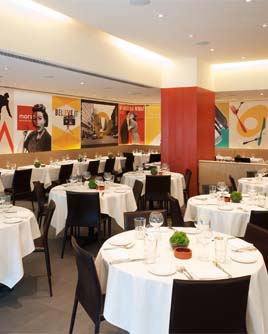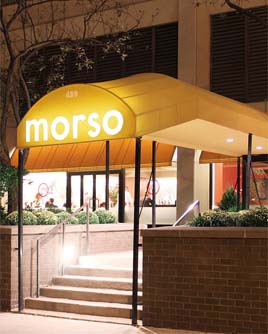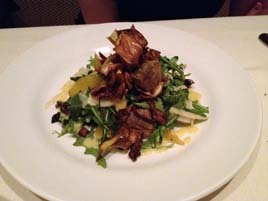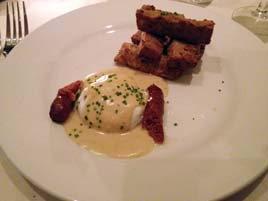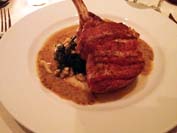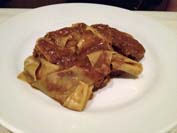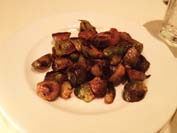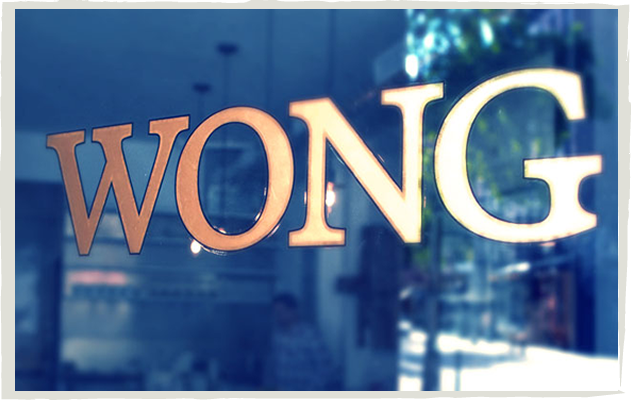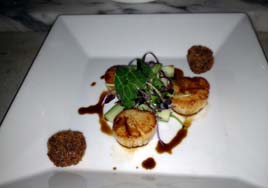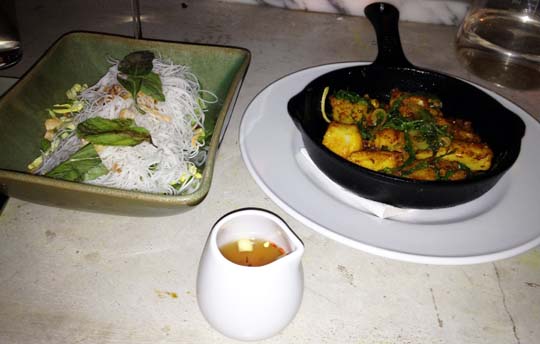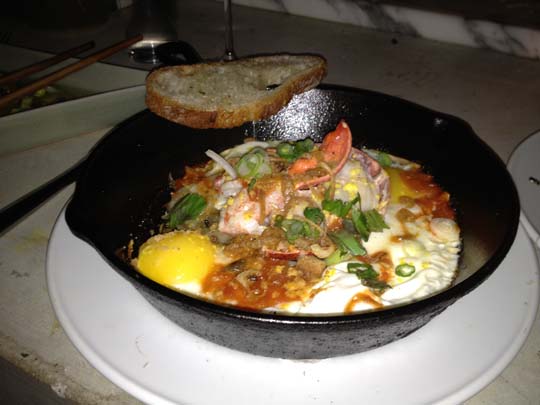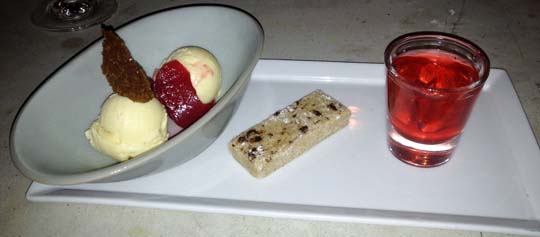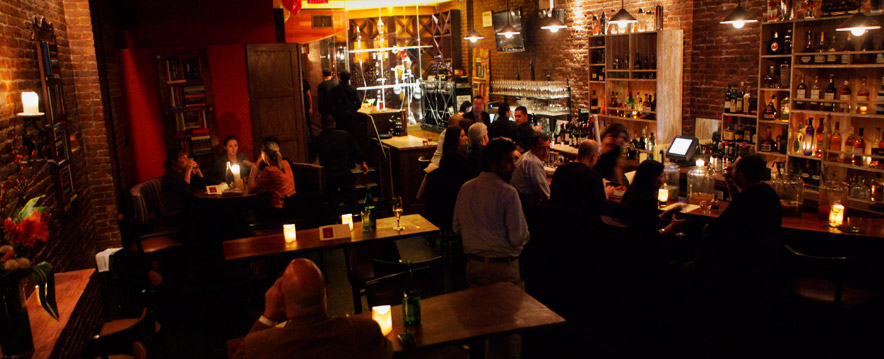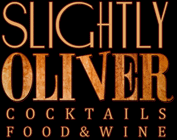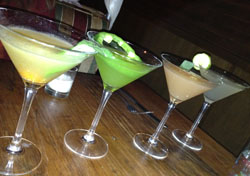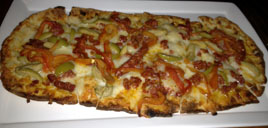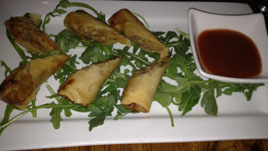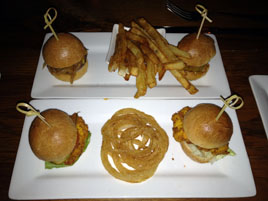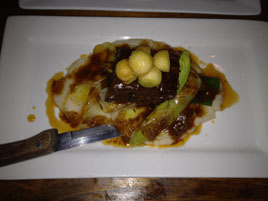North End Grill
 Monday, January 30, 2012 at 04:30PM
Monday, January 30, 2012 at 04:30PM Note: This is a review under founding chef Floyd Cardoz, who left the restaurant in April 2014. His replacement is Eric Korsh, formerly of Calliope.
*
 You’ve got to admire Danny Meyer’s sense of the moment. He put fine dining into Union Square before Union Square was hip. Then, he did it at Madison Square. Then, he built the nation’s best museum restaurant at MoMA—indeed, one of the city’s finest restaurants of any kind, regardless of location.
You’ve got to admire Danny Meyer’s sense of the moment. He put fine dining into Union Square before Union Square was hip. Then, he did it at Madison Square. Then, he built the nation’s best museum restaurant at MoMA—indeed, one of the city’s finest restaurants of any kind, regardless of location.
There are some lesser accomplishments: an overrated burger shack that will soon have more locations than McDonald’s (OK, I’m exaggerating); an undistinguished barbecue joint. But even ignoring those places, it’s a remarkable record.
He’s also loyal to those who are loyal to him. A year ago, he shuttered the pathmaking Indian restaurant, Tabla, the first Meyer establishment to close. You couldn’t call it a failure, as the place had been open for twelve years, but it had run its course. But he didn’t fire the chef. Instead, he kept the talented Floyd Cardoz on the payroll until he could find another gig worthy of his abilities.
 It didn’t take long. North End Grill has just opened in Battery Park City, along with a branch of that overrated burger shack and that undistinguished barbecue joint. They’ll all be hits.
It didn’t take long. North End Grill has just opened in Battery Park City, along with a branch of that overrated burger shack and that undistinguished barbecue joint. They’ll all be hits.
When the project was announced, Meyer noted the irony that Battery Park City has the city’s highest-income Zip code, but it has never had any particularly good restaurants. With the new Goldman Sachs headquarters around the block, Meyer figured it was time to give the neighborhood a try.
In that announcement, Meyer made the restaurant sound decidedly middlebrow:
“This fits in with my casual restaurants, like Union Square Cafe, the tavern at Gramercy Tavern, Maialino, and the Bar Room at the Modern,” Mr. Meyer said. “I don’t see this as a special-occasion place.”
He confirmed that Floyd Cardoz, formerly of Tabla, which closed at the end of 2010, will be the chef, with a menu dominated by seafood. A dining counter will face an open kitchen and there will be a bar for drinks, not food.
 North End Grill is much better than that. It is not as fancy as Meyer’s two remaining upscale restaurants, Gramercy Tavern and The Modern, but it’s quite a bit fancier than the other places he compared it to—the Tavern Room, the Bar Room, or Maialino.
North End Grill is much better than that. It is not as fancy as Meyer’s two remaining upscale restaurants, Gramercy Tavern and The Modern, but it’s quite a bit fancier than the other places he compared it to—the Tavern Room, the Bar Room, or Maialino.
By today’s standards, it is fine dining. The Goldman Sachs crowd will generate expense account business. Meyer was smart not to surrender that opportunity, and Floyd Cardoz shouldn’t be wasted on tavern food.
Meyer hedged his bets in other ways: the bar does serve food, and there’s a long communal table facing an open kitchen. But the main dining room (in the back, and not immediately visible when you enter) is smartly appointed in white and ebony trim, with crisp white tablecloths, comfortable banquetts, tables generously spaced, and captains in tie and jacket.
Whether you choose the bar or a sit-down meal, you’ll enjoy eating here.
 The menu is upper-mid-priced, with appetizers and salads $12–18, entrées $19–44 (most of them $26–34), sides $6–9. There’s a distinct seafood slant, which features in all the appetizers, but the entrées are about a 50 percent split between surf and turf.
The menu is upper-mid-priced, with appetizers and salads $12–18, entrées $19–44 (most of them $26–34), sides $6–9. There’s a distinct seafood slant, which features in all the appetizers, but the entrées are about a 50 percent split between surf and turf.
It isn’t a bold menu, especially the entrées: halibut, scallops, salmon, pork chop, lamb, duck, turbot, chicken, steak—practically, the laundry list of all the mains a “bar and grill” restaurant needs to serve, lacking only a burger.
But I was there on the second night of dinner service, and I’m sure North End Grill—like every other Danny Meyer restaurant—will gain focus as the restaurant gains its sea legs. For such an early visit (not my usual practice), the kitchen and the service team were remarkably sure-footed.


Cod Throats Meunière ($15; above left) is what passes for critic bait on this menu: the throat of the cod, dredged in flour and served in brown butter. The server compared it to sweetbreads, which was a fairly accurate description.
In an early candidate for Trend of the Year, there is a whole section of the menu for savory egg dishes. If they’re as good as the Tuna Tartare with Fried Quail Egg and Crispy Shallots ($16; above right), then I’d like to try them all.

The Ashley Farms Poulet Rouge ($52; above), one of three “×2” dishes on the menu, was excellent.
 So too was a side of Hashed Brussels Sprouts and Lentils ($8; right), which was like a rich, warm cole slaw.
So too was a side of Hashed Brussels Sprouts and Lentils ($8; right), which was like a rich, warm cole slaw.
The wine list, which is currently only one sheet of paper, offers a reasonable selection for a new restaurant, although the sommelier said that a longer and deeper list is on the way. For us, the 2007 Haut Médoc from Château Sociando-Mallet ($64) was just right.
The hard liquor department specializes in scotch, with dozens of whiskies in a wide price range. There are also several scotch-based cocktails; I tried the Stone Fence ($13), with, sparkling cider, Peychaud’s bitters, and soda.
This is a Danny Meyer restaurant, so it won’t surprise you that the service was spot-on, allowing for some obvious first-night nervousness that will surely have subsided by the time you read this. I wouldn’t be surprised if North End Grill is a three-star restaurant before long—or what passes for one, now that the classic kind is gradually disappearing. I’m a bit more conservative, but stay tuned.
North End Grill (104 North End Avenue at Vesey Street, Battery Park City)
Food: ★★
Service: ★★
Ambiance: ★★
Overall: ★★


